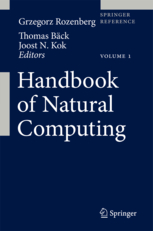
Handbook of Natural Computing
Rozenberg, Grzegorz; Bäck, Thomas; Kok, Joost N. (Eds.), 4 volumes, not available separately, 2012, LII, 2052 p.
ISBN: 978-3-540-92909-3 (Print)
ISBN: 978-3-540-92910-9 (Online)
Publisher: Springer Berlin Heidelberg
Editors: Grzegorz Rozenberg, Thomas Bäck, Joost N. Kok
Official Homepage: book on www.springer.com
Access: Open Access on Springerlink
Natural Computing is the field of research that investigates both human-designed computing inspired by nature and computing taking place in nature, i.e., it investigates models and computational techniques inspired by nature and also it investigates phenomena taking place in nature in terms of information processing.
Examples of the first strand of research, covered by the handbook, include:
• neural computation inspired by the functioning of the brain;
• evolutionary computation inspired by Darwinian evolution of species;
• cellular automata inspired by intercellular communication;
• swarm intelligence inspired by the behavior of groups of organisms;
• artificial immune systems inspired by the natural immune system;
• artificial life systems inspired by the properties of natural life in general;
• membrane computing inspired by the compartmentalized ways in which cells process information;
• and amorphous computing inspired by morphogenesis.
Other examples of natural-computing paradigms are molecular computing and quantum computing, where the goal is to replace traditional electronic hardware, e.g., by bioware in molecular computing. In molecular computing, data are encoded as biomolecules and then molecular biology tools are used to transform the data, thus performing computations. In quantum computing, one exploits quantum-mechanical phenomena to perform computations and secure communications more efficiently than classical physics and, hence, traditional hardware allows.
The second strand of research covered by the handbook, computation taking place in nature, is represented by investigations into, among others, the computational nature of self-assembly, which lies at the core of nanoscience, the computational nature of developmental processes, the computational nature of biochemical reactions, the computational nature of bacterial communication, the computational nature of brain processes, and the systems biology approach to bionetworks where cellular processes are treated in terms of communication and interaction, and, hence, in terms of computation.
Fields of research: Artificial Intelligence, Neural networks, Natural computing, Biologically inspired computing
Справочник может служить базовым пособием для студентов, учащихся специализированных курсов, аспирантов, программистов, изучающих вопросы, связанные с искусственным интеллектом. Кроме того, книга будет весьма полезна для разработчиков интеллектуального программного обеспечения и профессионалов, желающих расширить рамки избранной ими специальности.Электронный (англоязычный) вариант справочника доступен на сайте издательства Шпрингер:
Table of contents / Preface / Sample pages
Read this Book on Springerlink (Open Access): Look inside | Detailed description




